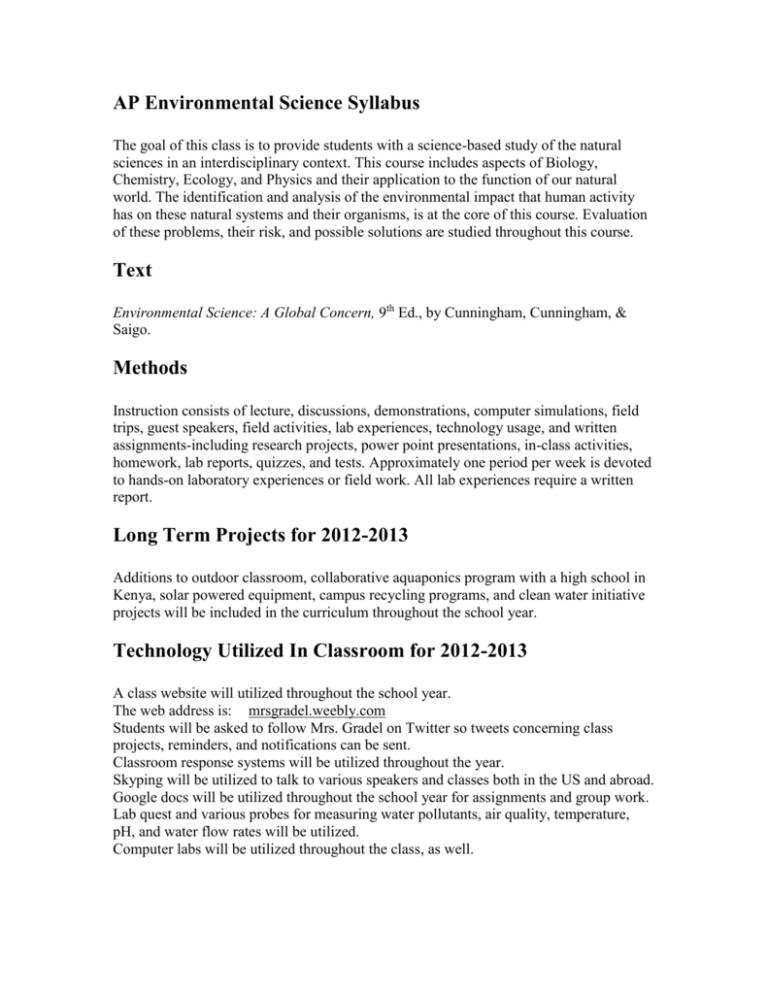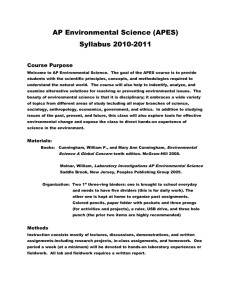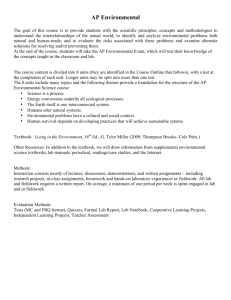AP Environmental Science Syllabus
advertisement

AP Environmental Science Syllabus The goal of this class is to provide students with a science-based study of the natural sciences in an interdisciplinary context. This course includes aspects of Biology, Chemistry, Ecology, and Physics and their application to the function of our natural world. The identification and analysis of the environmental impact that human activity has on these natural systems and their organisms, is at the core of this course. Evaluation of these problems, their risk, and possible solutions are studied throughout this course. Text Environmental Science: A Global Concern, 9th Ed., by Cunningham, Cunningham, & Saigo. Methods Instruction consists of lecture, discussions, demonstrations, computer simulations, field trips, guest speakers, field activities, lab experiences, technology usage, and written assignments-including research projects, power point presentations, in-class activities, homework, lab reports, quizzes, and tests. Approximately one period per week is devoted to hands-on laboratory experiences or field work. All lab experiences require a written report. Long Term Projects for 2012-2013 Additions to outdoor classroom, collaborative aquaponics program with a high school in Kenya, solar powered equipment, campus recycling programs, and clean water initiative projects will be included in the curriculum throughout the school year. Technology Utilized In Classroom for 2012-2013 A class website will utilized throughout the school year. The web address is: mrsgradel.weebly.com Students will be asked to follow Mrs. Gradel on Twitter so tweets concerning class projects, reminders, and notifications can be sent. Classroom response systems will be utilized throughout the year. Skyping will be utilized to talk to various speakers and classes both in the US and abroad. Google docs will be utilized throughout the school year for assignments and group work. Lab quest and various probes for measuring water pollutants, air quality, temperature, pH, and water flow rates will be utilized. Computer labs will be utilized throughout the class, as well. Unit 1-Chapters 1, 2, & 3 4 weeks Chapter 1 Topic: Understanding Our Environment A. Definition and overview of topics in environmental science B. History of environmentalism: US environmental history • Lab: Tragedy of Commons- This activity demonstrates to students Garret Hardin’s argument that commonly held resources will inevitably be degraded or destroyed due to self-interest outweighing public interests. Students will collect data and analyze results to determine if the argument holds true. C. Sustainable development Activity: Calculating your ecological footprint- students will mathematically calculate their personal footprint (impact) on the environment. Video: World Population Growth Chapter 2 Topic: Understanding Science, Systems, and Ethics A. What is science? •Lab: Effects of Ionizing Radiation on Seed Germination and Growth- Students measure the effects of 5 different dosage levels on seed germination and growth. Measurement data is collected over several weeks and statistical analysis is used to draw conclusions. B. Systems C. Environmental ethics Activity: Scientific notation activity Internet Activity: Interactive feedback loops Chapter 3 Topic: Matter, Energy, and Life A. Elements of life •Lab: DNA Extraction- Wheat germ DNA is extracted as students explore what types of agents will break down cellulose, fat, and protein. This information is related to environmental hazards and their effects on living organisms. B. Energy for life: populations, communities, food chains and webs C. Material cycles and life processes: biogeochemical cycles Computer Activity: Ecological pyramids Unit 1 TEST-Chapters 1, 2, & 3 Unit 2-Chapters 4, 5, & 12 4 weeks Chapter 4 Topic: Evolution, Biological Communities, and Species Interactions A. Evolution and speciation B. Species interactions C. Community properties •Lab: Measuring Primary Productivity- The concepts of wet versus dry weight, net productivity, respiration rates, gross productivity, and standing biomass are explored in this lab. Students will calculate the net productivity, respiration, and gross productivity of grass plots. D. Communities in transition Field Activity: Tagging and collection of tracking data on migrating Monarchs. Chapter 5 Topic: Biomes: Global Patterns of Life A. Terrestrial biomes B. Marine ecosystems C. Freshwater ecosystems •Lab: Soil Macro-biodiversity: Prairie (Grassland) Soil vs Temperate Deciduous Soil- Students use Berlese funnels and arthropod identification keys to identify organisms found in different biome soils. Biodiversity is calculated using the Shannon-Weiner Diversity index. Chapter 12 Topic: Land Use: Forests and Grasslands A. World forests B. Tropical/temperate forests C. US forest management D. Grasslands/rangelands Activity: GIS computer lab Video: Forest Wars Test: Chapters 4, 5, and 12 Unit 3-Chapters 6 & 7 2 ½ weeks Chapter 6 Topic: Population Biology A. Dynamics of population growth B. Factors that increase or decrease populations C. Factors that regulate population growth •Lab: Capture/recapture population estimation- Students utilize the Lincoln’s Index to estimate the population size of local grasshoppers. D. Conservation biology Chapter 7 Topic: Human Populations A. Human population growth and limits B. Human demography •Lab: Human Population: Changes in Survival- Students will gather data from the San Francisco County Genealogy Obituaries and current local newspapers to understand the difference in human mortality and survivorship between past and modern times. Students will analyze how these changes have influenced population growth. C. Demographic transition D. Family planning and fertility control Computer lab: Students use census data to construct age-sex population pyramids and analyze how population is affected by various environmental factors. Test: Chapters 6 and 7 Unit 4- Chapters 8, 9 , & 10 4½ weeks Chapter 8 Topic: Environmental Health and Toxicology A. Pandemics/ environmental health B. Toxicology: Movement, distribution, and fate of toxins C. Measuring toxicity •Lab: Dose/Response Bioassay using Lettuce Seeds- Students will make serial dilutions and expose lettuce seeds to various concentrations of chemicals. Students will determine the LD-50 for each chemical, chart, and graph results. D. Risk assessment and acceptance Activity: Risk Assessment Data Collection and Statistical Analysis Chapter 9 Topic: Food and Agriculture A. Food and Nutrition: Key food sources B. Soil: A renewable resource: How it is used and abused •Lab: Soil: The Wealth Beneath Your Feet- Students collect soil samples from 3 different ecosystems and run tests on the texture, structure, and characteristics of the soil samples. Sample data is recorded and statistically analyzed. C. New crops and genetic engineering D. Sustainable agriculture Activity: Group presentations on sustainable agriculture Chapter 10 Topic: Pest Control A. Pests and pesticides B. Pesticide benefits and problems C. Alternatives to pesticide use/ reducing exposure Internet Activity: Integrated Pest Management Techniques Test: Chapters 8, 9, & 10 Semester Final End of First Semester Unit 5 Chapter 11 Topic: Biodiversity A. Biodiversity/hot spots/benefits B. What threatens biodiversity/over-harvesting ( fish) C. Endangered species management and laws D. Captive breeding and species survival plans Activity: Invasive Species Wanted Posters and Presentations Video: Endangered Species: National Geographic Chapter 13 Topic: Preserving and Restoring Nature A. Parks and nature preserves B. Wilderness areas and wildlife refuges 2 1/2weeks C. Preserving ecosystems and restoration ecology •Lab: Flow Rates- Students will use power source, water pumps, and channels to measure and calculate the flow rate of water through channels at various voltages and elevations. Students will then apply their understanding to the study of the Everglades Restoration Project. Test: Chapters 11 and 13 Unit 6 4 weeks Chapter 14 Topic: Geology and Earth Resources A. Dynamic planet-plate tectonics B. Minerals and rocks/ geology and mineralogy C. Environmental effects of resource extraction/ conserving resources D. Geologic hazards-earthquakes, volcanoes, landslides, tsunamis •Lab: Erosion Rates- Students are to design their own experiment testing the effects of several variables such as flow rate, water temperature, etc. on the rate of erosion. These experiments are to be transferred into the field and tested on local creek systems. Chapter 15 Topic: Air, Weather, and Climate A. Atmosphere and climate B. El Nino/ La Nina C. Global warming/climate change Guest Speaker: Oklahoma University Meteorology School-Climate change Video: Global Warming Chapter 16 Topic: Air Pollution A. Natural sources of air pollution B. Human-caused air pollution •Lab: Qualitative Analysis of Vehicle Exhaust: A vehicle’s engine is usually directly proportional to the amount of pollution produced and emitted through its exhaust pipe. Students will collect, observe, and make qualitative evaluations of vehicle efficiency. C. Effects of air pollution D. Clean air legislation •Lab: Ozone Levels: Students will take ozone measurements of 5 different sites in the Tulsa metro area. Measurements will be taken over a four month period and data recorded. The five locations will compare rural to urban settings. Test: Chapters 14, 15, and 16 Unit 7 3 weeks Chapter 17 Topic: Water Use and Management A. Water resources/major components B. Water availability, usage, and shortages C. Increasing water supplies/ management and conservation •Lab: Water Filter Contest: Students will design and test a water filter on contaminated water. The water will be put through a battery of pre and post tests and results recorded. The most effective filter wins the contest. After evaluations are made, design corrections are made and tests rerun. Chapter 18 Topic: Water Pollution A. Types and effects of water pollution B. Water pollution control/quality C. Water legislation •Lab: Creek Water Analysis- Students will monitor 5 sites along a nearby creek by collecting and testing water samples once a month during the spring semester. Soil samples are also taken from the bank and watershed area of each site and tested in class. One part of the creek lies adjacent to an open, undisturbed field, while another area lies next to a recently constructed housing development. Water and soil samples are being monitored for possible run-off. Test: Chapters 17 and 18 Unit 8 3 ½ weeks Chapter 19 Topic: Conventional Energy A. Energy: What is it? Where do we get it? How is it used? B. Coal, oil, natural gas C. Nuclear power/radioactive waste management D. US energy policies •Lab: Home Energy Audit: Electricity Usage- Students are to find a way to measure the amount of electricity used in their own home, analyze their data, design a conservation plan, and equate their electricity use to carbon dioxide emission. Chapter 20 Topic: Sustainable Energy A. Conservation: Transportation, electricity, heat B. Solar energy, fuel cells, biomass C. Energy from the Earth’s forces: water, wind, geothermal D. Energy future •Lab: Solar House Design- Students will design and build a model solar house using their knowledge of passive and active solar house designs. The ability of the house to remain cool in the summer and retain heat during the winter will be tested. Guest Speaker: Tulsa University Chemical Engineering Dept.-Hydrogen car and fuel cell technology. Video: Renewable Energy: Discovery Activity: Analysis of Top Ten Green Companies Test: Chapters 19 & 20 Unit 9 2 ½ weeks Chapter 21 Topic: Solid, Toxic, and Hazardous Waste A. Solid waste disposal B. Recycling, reusing, reducing •Lab: Solid Waste Inventory: Conservation Plan- Students are to record all the solid waste their household disposes over a 3-day period, categorize it, and design a conservation plan for their house utilizing the recycling, reusing, and reducing principles. C. Hazardous and toxic waste/superfund sites Chapter 22 Topic: Urbanization and Sustainable Cities A. Urbanization/immigration/government policies B. Urban challenges in developing and developed countries •Lab: Land-Use Plan- Students are to use ecological principles in developing a land-use plan for a coastal area. They are to identify the environmental impacts of their development and are required to abide by all zoning ordinances and wetlands regulations. Chapter 23 Topic: Ecological Economies A. Economic worldviews B. Populations, technology, and scarcity C. GNP, cost-benefit analysis, trade, and development Activity: Students are to design an eco-efficient business and present it to the class. Chapter 24 Topic: Environmental Policy, Law, and Planning A. Environmental policy and law B. International treaties and conventions C. Dispute resolution and planning Guest speaker: Attorney –Environmental law and geopolitics Test Chapters 21, 22, 23 and 24 AP Test Review Field Trip: 2nd Semester- Tulsa Mohawk Water Treatment Plant, Captive Breeding program at Tulsa Zoo, and Tulsa Riverside Power Plant







